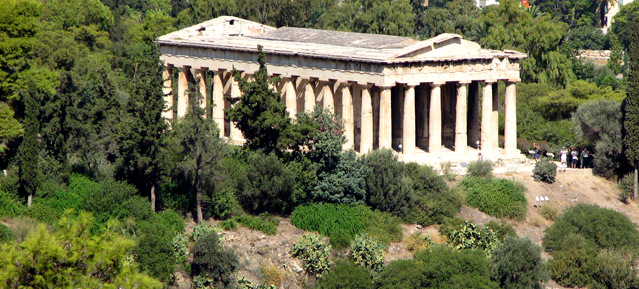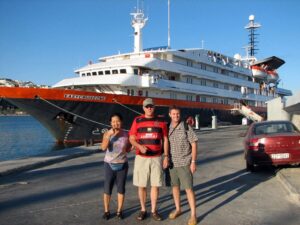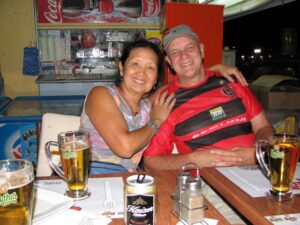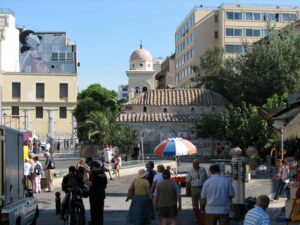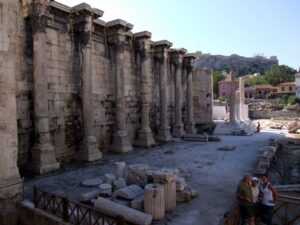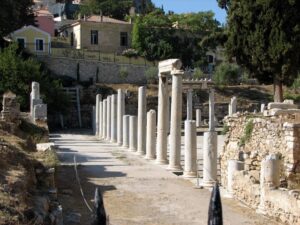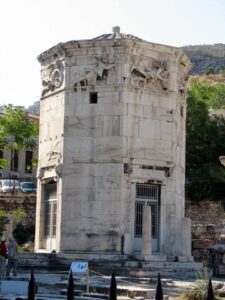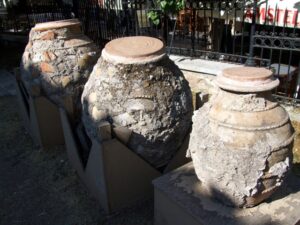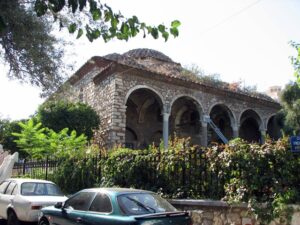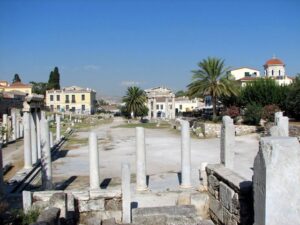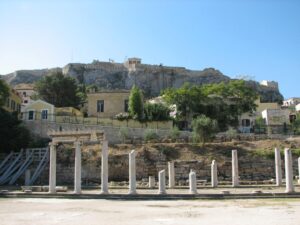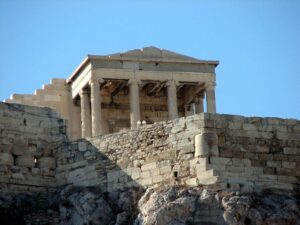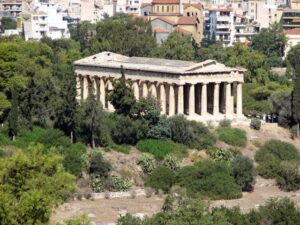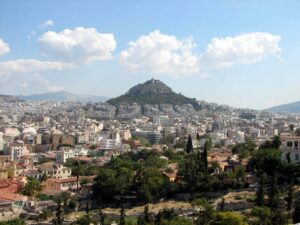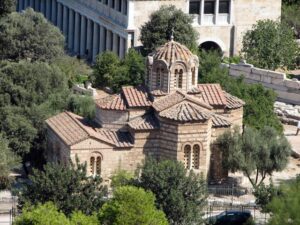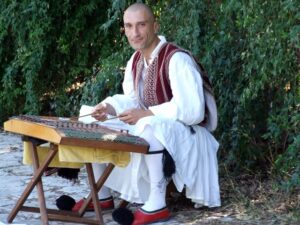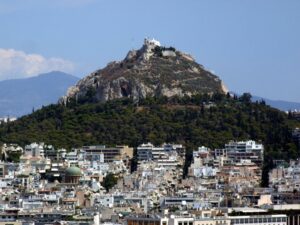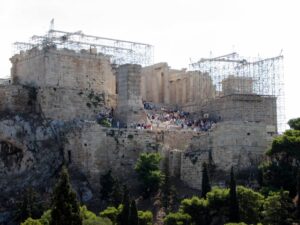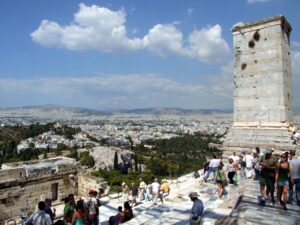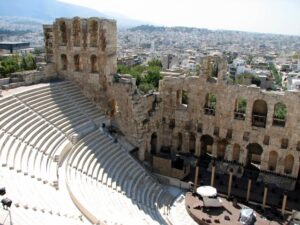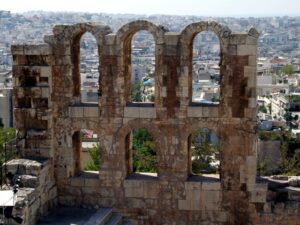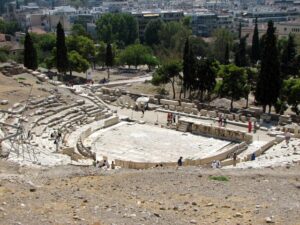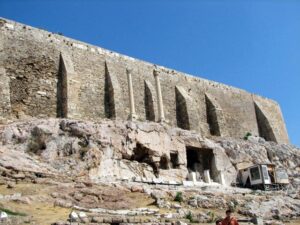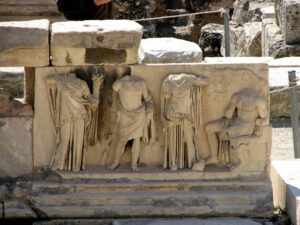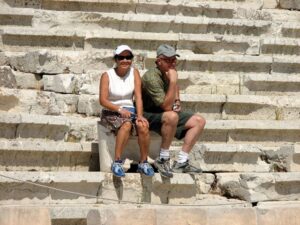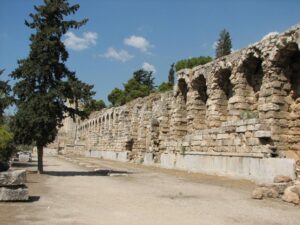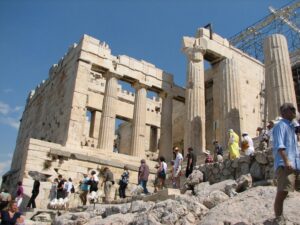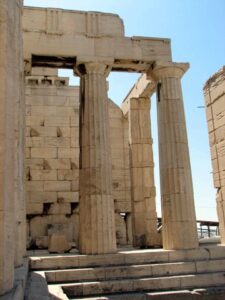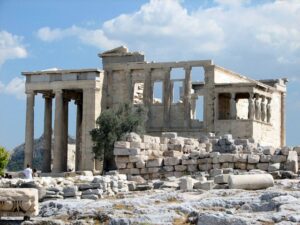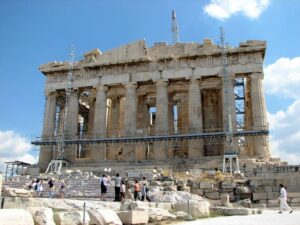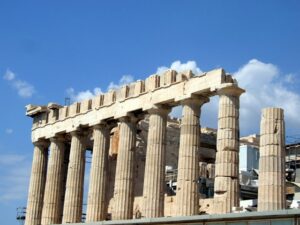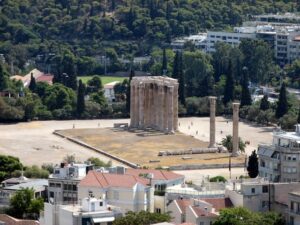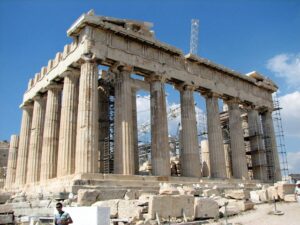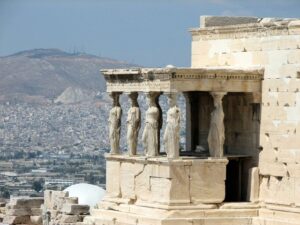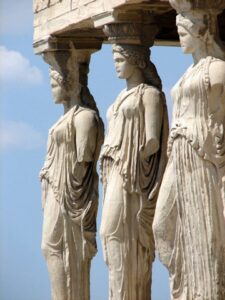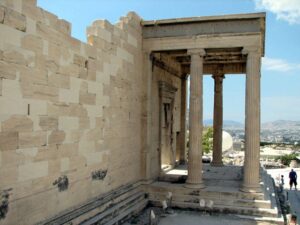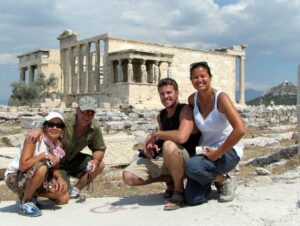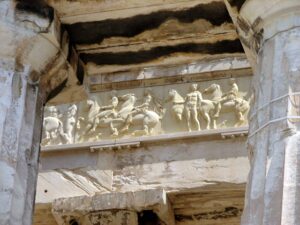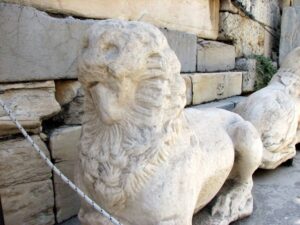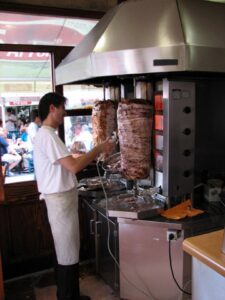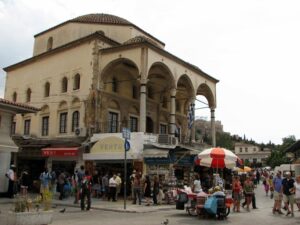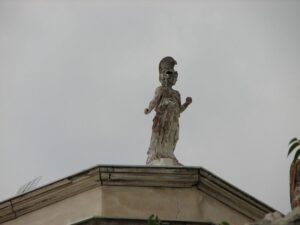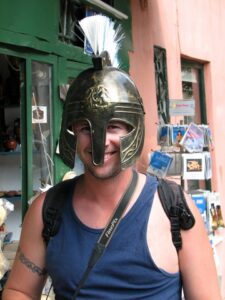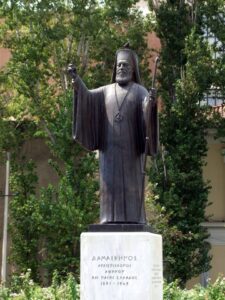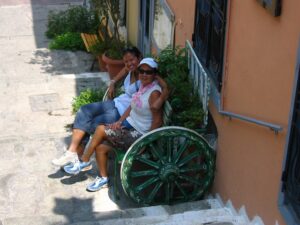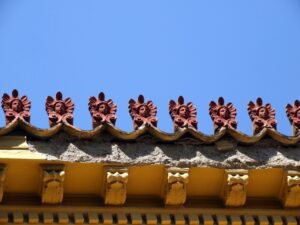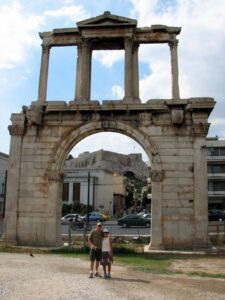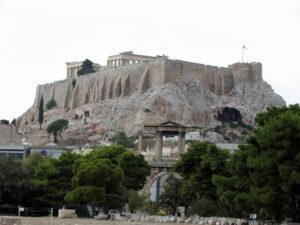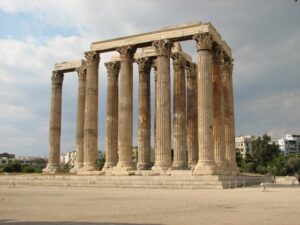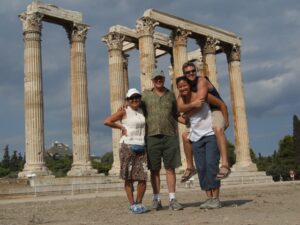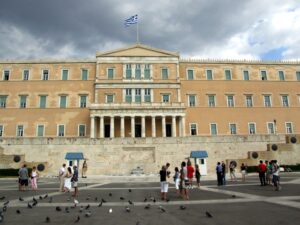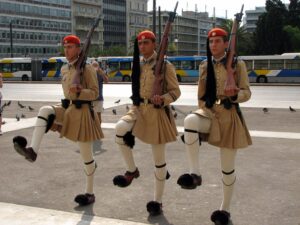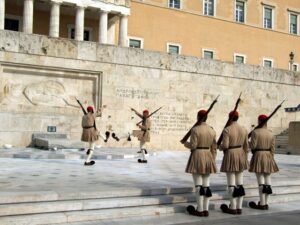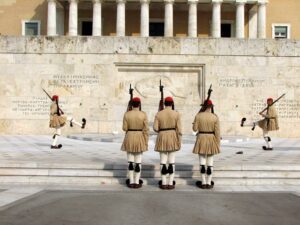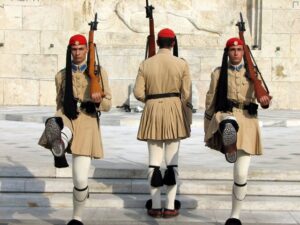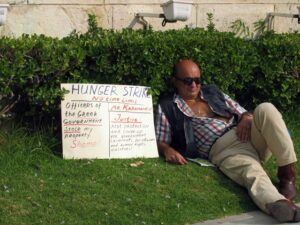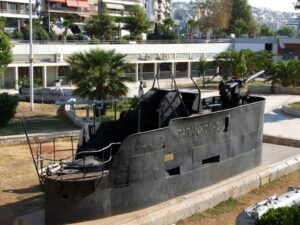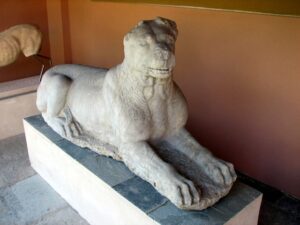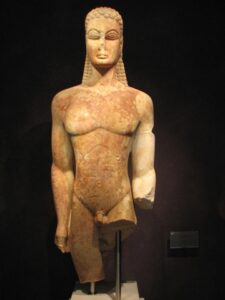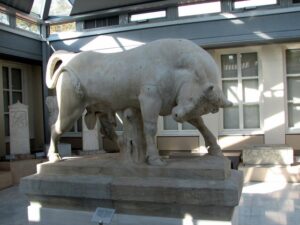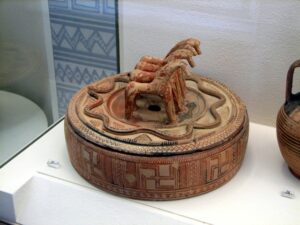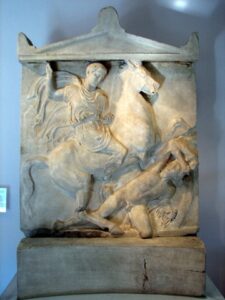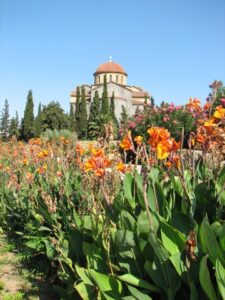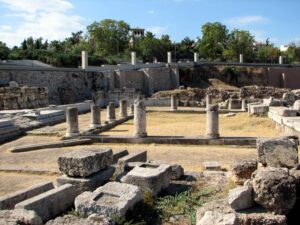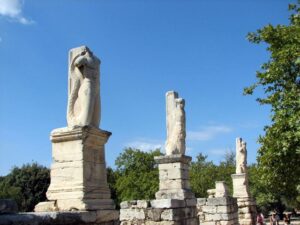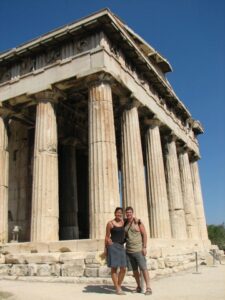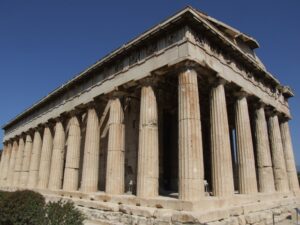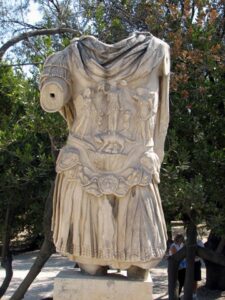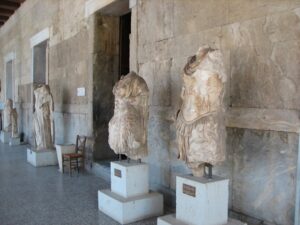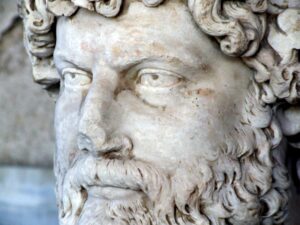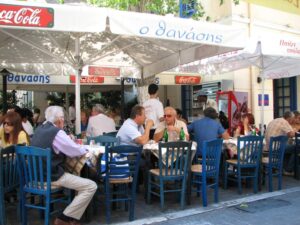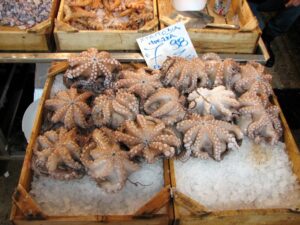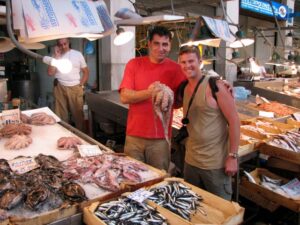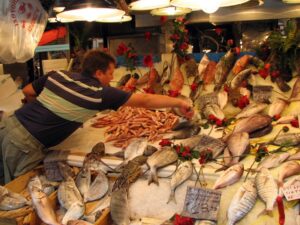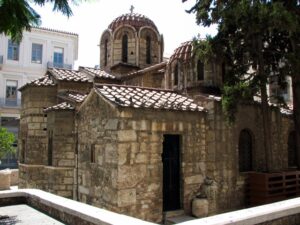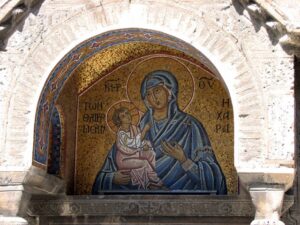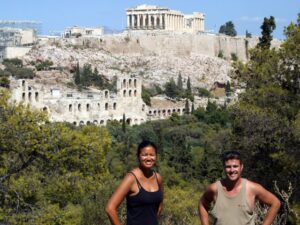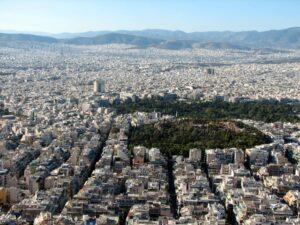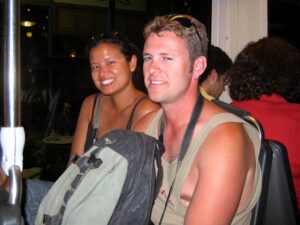In September 2007, we booked a two week EasyCruise trip that departed from Athen’s Marina Zea in Piraeus. While we were on board for 14 days, the cruise ship did a series of loops: Athens, Mykonos, Paros, Sifnos, (return to Athens to drop off/pick up or sightsee), Poros, Spetses, (Athens again), Milos, Ios, Amorgos, Naxos, Folegandos (which ended up being beautiful Syros instead due to inclement weather), Serifos, and lastly a return back to Athens for disembarkation. We enjoyed having several days in the capital city of Athens as it is Europe’s 8th largest city and warrants a few days exploration.
6 Sep 2007: Some people say that the 2004 Olympics was the best thing to happen to Athens in recent memory. After visiting in 1999 (and surviving our maniac driver’s race car antics on the chaotic streets of Athens), we have to agree…especially after taking an inexpensive ride on Athen’s new, shiny, safe and clean metro lines. What a difference a few years makes! Ok, so the Greek Drachma is now long gone (and sorely missed), replaced by the dollar crushing Euro, but hey, sometimes in life trade-offs are necessary. On one hand we rejoiced at the miracle of Athen’s efficient, affordable, and speedy public transport, while on the other hand, we lamented the high costs of visiting what used to be an affordable European country.
First things first…how to find our Easy Cruise ship? We followed the signs at Athens International Airport for the Metro and bought our tickets at the ticket booth for 5 Euros a piece for door to door service. Just remember to validate your ticket prior to hopping on the metro as there were warning signs a plenty advising you that failure to validate the ticket would result in a fine equivalent to 60 times the price of the ticket! The metros are color coded (Green, Red, or Blue) but we found that just asking the locals to ensure we were on the right metro worked like a charm. The Blue line took us all the way to Monastiraki where we had to hop off and catch the Green line towards Piraeus. At the Piraeus terminal, we walked out a side exit, and caught bus 904 towards Zea Marina. Believe it or not, but it took us less than 2 hours to get from the airport and checked in on our cruise at Zea Marina (the orange Easy Cruise vessel was pretty easy to spot from the bus).
Our cabin was windowless but much more spacious than the cabin we had in the Caribbean. Once we got settled in, we linked up with Becky’s parents Bob and Ann who had already checked in a couple of hours earlier and decided to go out for an afternoon stroll around Zea Marina in search of some beer and some grub. The beer was easy to find, as was the grub (lamb kebabs saturated with tsatsiki sauce…yum yum). There were plenty of souvlaki stands lining the waterfront, so we just stopped at the first one that looked appealing. A couple of beers later, jetlag kicked in, so we called it a night and caught some shut eye. Off to Mykonos tomorrow!
10 Sep: Even though our daily cruise news indicated we would be arriving into Piraeus around 9 am, we were able to disembark earlier than expected. Getting back into the city from Piraeus was cheap and easy. The 904 bus takes a circular route so we hopped on that for 50 cents and got off at the Piraeus stop, where for 70 cents we caught a metro to Monastiraki station. Our plan today was to purchase the 12 Euro Athens’s ticket that granted us entry into several Athenian sights over a multi-day period. In addition to entry at the Acropolis, we could visit the Ancient Agora, Theatre of Dionysos, Roman Agora, Kerameikos, and Temple of Olympian Zeus. While all of that was a bit too busy for one day, we decided we would be doing well if we tackled the Acropolis (a must see), the Roman Agora, and whatever else we happened to chance upon.
Our first stop was the Roman Agora (on Aeolou street), where we examined the Tower of Winds. This octagonal tower was built originally as a meteorological station in the 1 st Century. Inside the building, a water clock used to operate using the water running down from the Acropolis. The exterior friezes of the tower really caught our attention though, as the friezes represent the direction of the winds along with their differing personalities. The Tower of Winds is part of the Roman Agora, which was the commercial center of the ancient city of Athens. The Roman Agora consists of a large, rectangular open courtyard that used to be surrounded by shops, stoa, and storerooms. The Fetiye Mosque is picturesque, although we read that its minaret was destroyed shortly after Greece won its independence. We were glad we stopped by here for a quick view, but our real goal for the day was a visit to the Acropolis, so we followed the steps leading up past the Ancient Agora and towards the Areopagus Rock for a fine view over the Ancient Agora.
We joined the teaming crowds of tourists heading up to visit the Acropolis at 1130 am, but we knew that with lunchtime looming, the crowds would thin out in a few hours. At the southwestern corner of the Acropolis, we stopped to look at the reconstructed Herodes Atticus theater. We heard that performances occurred here nightly, but at 60 Euros a ticket for good seats, the show was a bit out of our budget. The ruins of the Theatre of Dionysus looked like they were just a short walk away, so we figured we’d head over there for a quick glance before heading up through Beule Gate and the Propylaea towards the Acropolis. Amazingly, only a fraction of Dionysus’s Theatre has been uncovered, but you can easily envision what it must have looked like in its heyday.
The Acropolis does not disappoint. Despite the crowds, the heat, and our growing hunger, we were glad visited Athens’s most famous landmark. Defined as an “upper city”, we could easily see why the city’s residents would seek refuge here during an invasion (the Acropolis commands an imposing view over the entire city). In ancient Greece, all the city states were built around an acropolis, and many of the city’s sacred buildings were built atop these safe havens.
We quickly realized how futile it is to take a picturesque photo at the Parthenon…there are tons of tourists all vying for that same “perfect” shot. Don’t even fret or get anxious trying to follow suit, as the postcard vendors definitely win this feat hands down. Nowadays, the Parthenon is undergoing a massive facelift, and there is ugly scaffolding everywhere. We can only imagine how nice the Acropolis will look again upon completion of the renovations.
The Erecthion is the most sacred site of the Acropolis, and the porch of the caryatids is particularly striking (even though they are replicas). A good lookout point is where the Greek flag is mounted, as you can see for miles and miles overlooking Athens’s suburbs. The massive ruins of the Temple of Olympian Zeus beckoned us from this vantage point, and decided that would be our next stop after lunch.
Our midday meal was a simple kebab or two at Monastiraki’s gyros stands downed with some local beer. Gyros choices were chicken, pork or beef/lamb, topped with fillings and tasty tsatsiki…absolutely filling, delicious and cheap. Lunch was topped off with some gelato (not so cheap), and afterwards, we were refueled with energy to explore this friendly and easy to navigate city.
After strolling around the plaka for a bit, we finally made it over towards the Temple of Olympian Zeus, which is the largest of all Greek temples. It took several centuries to build, and all that remains of it today are 15 massive Corinthian columns…absolutely stunning. We felt miniscule in comparison to this temple. While we taking photos, it was challenging to show how large the temple really is. Unless someone happens to stand directly at the base of the columns, it is hard to gain perspective of the enormity of this temple.
Bob was ready for a snooze after visiting Olympian Zeus, but we figured we’d hit Syntagma’s Parliament building to watch the changing of the Evzone soldiers before calling it quits. The changing of the guard is quite a spectacle, as a crowd of tourists gather up every hour on the hour to witness the Evzone’s jerky, marionette-like, choreographed movements. We read that only the handsomest men are invited to join the evzones, and they have to fall within stringent height/weight standards. Becky can attest that the handsome part of the rumor is true…the guards are very good looking in their smart uniforms.
After hanging out in the National Gardens to rest our aching feet, we decided that Easy Cruise’s hot tub had our names written all over it, so we caught public transport back to Piraeus and finished up our night there. The hot tub was the perfect solution to a full day of sightseeing, and we found a perfect Italian joint out in Zea Marina to fill our bellies. Two thumbs up for Athens! And we still have one more day here after cruising to Poros and Spetses.
13 Sep: After seeing the Acropolis on our first venture into Athens, we were kind of in a quandary as to how to spend our second day trip in the city, but soon found more than enough to occupy our entire day. Our 12 Euro Athens’s ticket included entry to the Kerameikos Tombs and Ancient Agora, so we decided we’d give those two sights a whirl. The Kerameikos cemetery was our first stop, and we hopped off at the Thissio metro stop. From there, it was an easy stroll to the main entrance into the ruins. Our guidebook informed us that the outer walls of ancient Athens used to run through Kerameikos, which once formed the edge of the classical city. Warriors and priestesses returned to Athens via two separate roads that passed through Kerameikos. One road led to a brothel and the other led to a temple. The tombs are famous because statesmen and heroes are buried here beneath the showy tombs lining the ancient roadways. Shadier activities also occurred here such as money lending, prostitution, and wine selling. It all made for a fascinating stop, with a walkthrough of the excellent Oberlaender museum (which displayed finds from the burial sites). The marble bull from the tomb of Dionysios of Kollytos was the most recognizable monument here, although there were several more equally as fascinating.
From Keramikos, it was an easy walk to the main entrance of the Ancient Agora. We had seen the perfectly preserved classical temple of Hephaesteion from Areopagus Rock, and wanted to see its original friezes (depicting the deeds of Herakles and Theseus) in person. This 415 BC temple is in remarkable shape, and is the showpiece of the agora. We had no idea how historic Athens’s ancient marketplace was. Our guidebook informed us that Socrates used to address the public here, democracy was born at this very spot, and St Paul used to preach the gospel on these very grounds. Very heady stuff! Another interesting monument was the Odeon of Agrippa, a theater that is in ruins. The three statues in front of it feature serpent tailed giants and tritons on huge plinths. Lastly, we took a stroll through the stoa of Attalos which was renovated in the 1950s and now houses the Agora’s museums. After a busy morning, we decided a quick break for lunch was in order and stopped by our favorite souvlaki stand.
Our afternoon agenda included a stop at the central market, where we were thrilled to meet cheeky (but friendly) vendors who were more than happy to showcase their wares. Be forewarned…the meat market will have all types of fresh meat for sale, oftentimes with tufts of fur still on display. We weren’t used to seeing cute bunny rabbits strung up by their hind legs or pig heads hung on hooks in a row. The fish market was also quite lively, with tons of fresh seafood for sale…the octopus, squid, and fish all looked so tempting!
After stopping to buy some lapis lazuli jewelry, we decided to split up as Bob and Ann just wanted to relax for a bit, while we were eager to walk up Filopappos Hill for a panorama view overlooking Athens proper. It was a surprisingly easy stroll, and remnants of the Filopappos Monument (built for Roman Senator Gaius Julius Antiochus Filopappos) mark the pinnacle of the hill. Senator Filopappos loved Greece so much he retired in Athens, and the Greeks built this monument to show the world they reciprocated the love by adopting him as an Athenian citizen. It’s partially destroyed today but in decent condition.
Next on our agenda was a stop at the Benaki Museum. Lucky for us, Thursdays are free entry days, along with extended hours (9 am – 10 pm). This museum was founded by Antonis Benakis in 1930. Benakis was from a prominent Greek family living in Alexandria, Egypt and his legacy showcases a stunning collection of over 20,000 personal items. These items are thoughtfully displayed in 36 rooms of a beautiful mansion museum that was donated to Greece by Benakis’s family. Our favorite displays were the first floor’s costumes, wood carvings, and the recreated Byzantine reception rooms. This was a nice surprise as we are not normally enamored with museums… Benaki Museum was definitely worth a visit.
Sunset was just about an hour away when we decided to hike up to Mount Lykavittos, the tallest of Athens’s seven surrounding hills. The funicular cost an outrageous 5 Euros per person round-trip, but we figured the hike up to the summit wouldn’t be that tough and it would be free. We left Bob and Ann at the base as we hiked up to the top, and to our surprise, they joined us several minutes later. Boy those two sure can hang! The Chapel of Saint George crowns the summit, and the 360 view is amazing.
Afterwards, we headed back down towards Monastiraki and did a bit more shopping before the stores closed for the day. Between the hours of 1500 – 1700, most stores take an afternoon siesta, but at night, they were conducting brisk business. Loaded with our purchases, we hopped back on the metro/bus towards Piraeus where we stopped at our favorite Italian joint for dinner. Overall, we’d have to say that Athens has been a fun capital city to while away a day or two!
